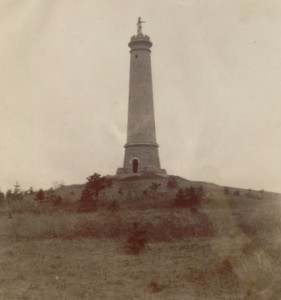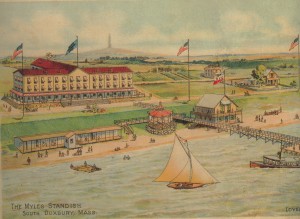Duxbury in Brief: A Historical Sketch
The area now known as Duxbury was inhabited by Native Americans as early as 12,000 to 9,000 B.C. By the time European settlers arrived here, the region was inhabited by the Wampanoags who called this place Mattakeesett, meaning “place of many fish.” Here the Native Americans cleared land for crops, hunted game both small and large, and fished along the many brooks.
In 1620, the English settlers known as the Pilgrims established their colony in Plymouth. Some families came to establish a new religious community, others for the opportunity to own land and improve their lives. It was a small group whose number increased slowly at first. Per the terms of their contract with financial backers in London, they were required to live together in a tight community for seven years. At the end of that term, in 1627, land along the coast was allotted to settlers for farming. Each man was given twenty acres for himself and an additional twenty for each person in his family. Thus, the coastline from Plymouth to Marshfield was parceled out and many settlers began moving away from Plymouth.
At first, those who settled in Duxbury came to work their new farms just in the warmer months and returned to Plymouth during the winter. It was not long, however, before they began to build homes on their land, and soon requested permission from the colony to be set off as a separate community with their own church. Duxbury, which originally included land that is now Pembroke and Bridgewater, was incorporated in 1637.
Some of the most influential men in the colony received grants in Duxbury and became its first leaders. Captain Myles Standish, the military leader of the colony, lived in “the Nook,” an area now known as Standish Shore. Elder William Brewster was for many years the religious leader of the colony. He probably led services in Duxbury until it received its own minister in 1637. John Alden was another important settler, Assistant Governor of the colony for fifty years. His house, now a museum on Alden Street, was the site of many important meetings of the colony’s leaders. The graves of many of Duxbury’s first settlers can be found in the Old Burying Ground on Chestnut Street, next to the site of original Meeting House.
Duxbury was primarily a farming community throughout the 17th and 18th centuries. It’s quiet history in the 18th century was interrupted only by the Revolutionary War. In the years leading up to the war, the community was solidly rebellious and had little tolerance for loyalists. Research has shown that a large majority of able bodied men in Duxbury served the revolutionary cause at some point during the war. Duxbury men served during the seige of Boston in 1776. They joined militia companies to meet threats of invasion in Rhode Island. Duxbury fishermen served on board privateers. One Duxbury vessel was even captured by the British off Duxbury Beach.
The Maritime Era
The most remarkable period in Duxbury’s history, the shipbuilding era, began immediately after the Revolution. Following the Treaty of Paris, the newborn nation was granted fishing rights on the Grand Banks. Several families took advantage of the new opportunity and began to build large fishing schooners. Soon, as foreign nations began to ease trade restrictions, Duxbury mariners found that they could trade all over the world. The schooners built in the 1790s gave way to larger brigs and eventually three-masted ships. The builders of fishing vessels soon became owners of merchant fleets, and Duxbury prospered.
By the 1840s, Duxbury boasted about 20 shipyards and was the largest producer of sailing vessels on the South Shore. With an average of ten vessels built every year between 1790-1830, the accomplishments of the Duxbury shipbuilding families rank among the more significant in Massachusetts maritime history.
There are few physical traces of this remarkable industry remaining today. The town is fortunate, however, in that an unusual number of federal period houses have survived. Along Washington Street, St. George Street, and Powder Point Avenue, one can view the homes of Duxbury shipwrights, sailors, master mariners and merchants. Many of the homes are in a remarkable state of preservation.
There were four shipbuilding families that stood out from the rest—the Westons, the Drews, the Winsors, and the Spragues. These families were responsible for producing at least 180 vessels which traded in ports around the world. Although no true innovations in shipbuilding were made in Duxbury, it’s ships were known worldwide for their fine construction.
The largest industry in Duxbury was owned by Ezra Weston, who came to be known as “King Caesar” due to his success and influence. A man with a driving ambition, Weston began building small vessels in 1764 and soon became famous for his successful merchant fleet. His son, Ezra II, who inherited his father’s kingly sobriquet, would bring the industry to its height. By 1840, the younger King Caesar had constructed the largest vessel built in New England up to that time. The ship Hope was an astounding 880 tons. Lloyd’s of London recognized Weston as the owner of the largest fleet in America, and this judgement was confirmed by Daniel Webster in a speech in 1841. His empire, a fore-runner of vertical integration, dominated the town. His lumber was grown and hauled from his own land in west Duxbury. The canvas for his sails was produced at a Weston-owned mill. His ships were provisioned by his own farms and herds.
The shipbuilding era in Duxbury ended as quickly as it began. By the 1850s sailing vessels were made obsolete by other modes of transportation such as steamships and railroads. While other Massachusetts towns grew, Duxbury went into a long economic decline.
Summer Visitors
By the 1870s, Duxbury’s rural character and unspoiled bay began to attract summer visitors. Duxbury soon gained a reputation as an idyllic summer resort. With the completion of the Duxbury and Cohasset railroad line, large numbers of city-folk from Boston could pay their $1.50 for a round trip ticket and enjoy Duxbury’s refreshing environment. Boarding houses sprang up everywhere. The Miles Standish Hotel on the Nook soon became enormously popular, and a small settlement of summer cottages appeared nearby along what is now Marshall Street. The Myles Standish monument, completed in 1898, was a result of this tourist influx.
This pattern continued in Duxbury well into the 20th century. It was not until the construction of Route 3 that transportation to Boston became expedient and the town’s population exploded with the arrival of thousands of year-round residents.



